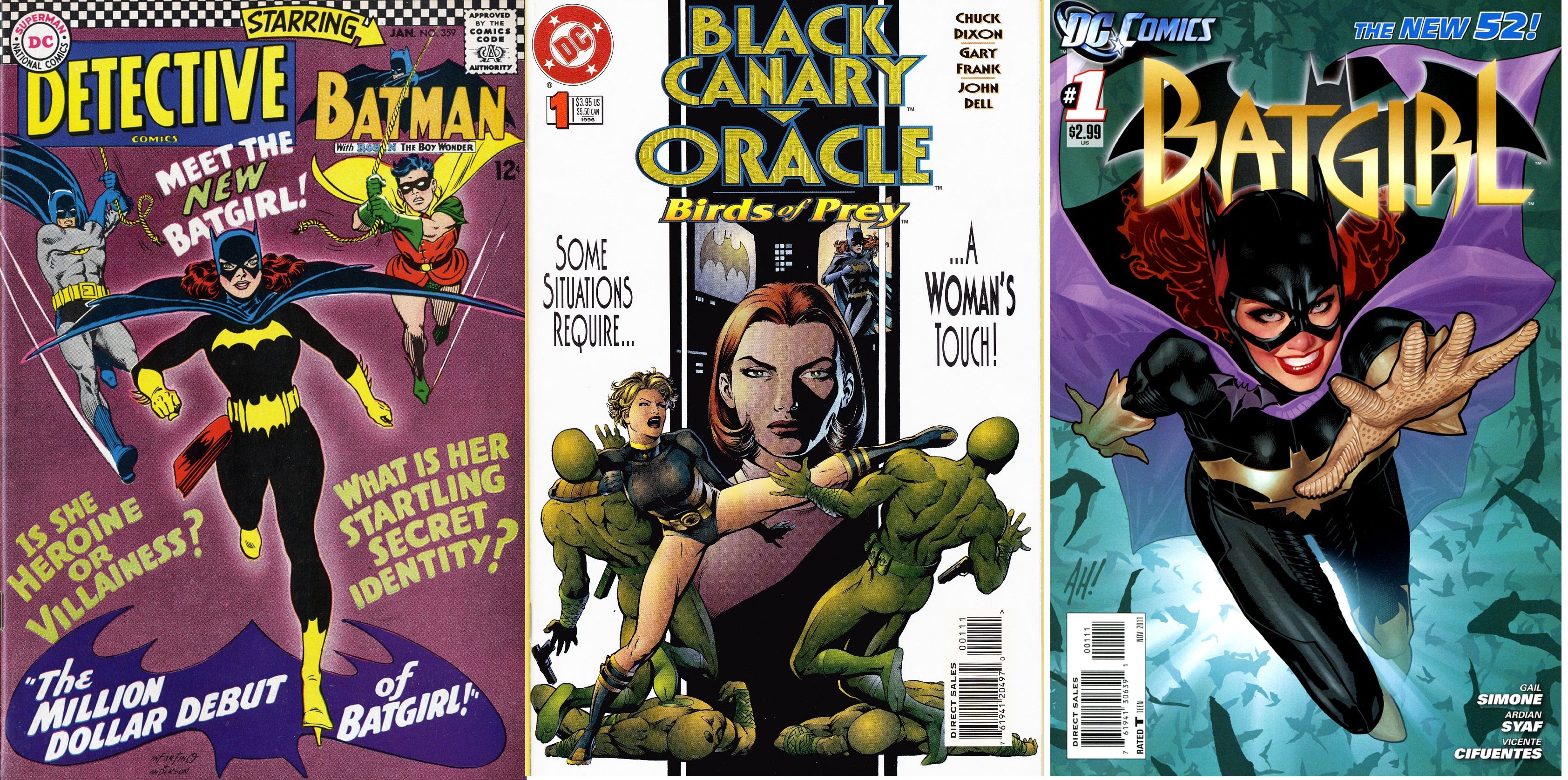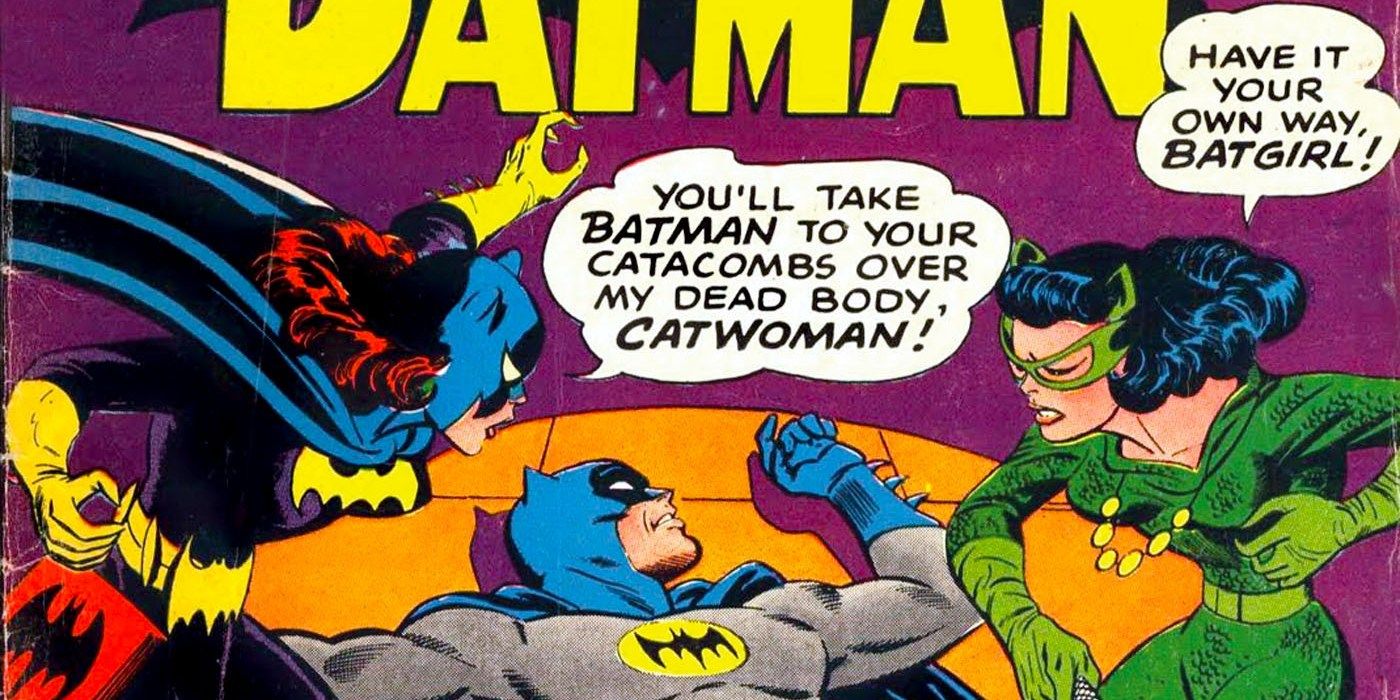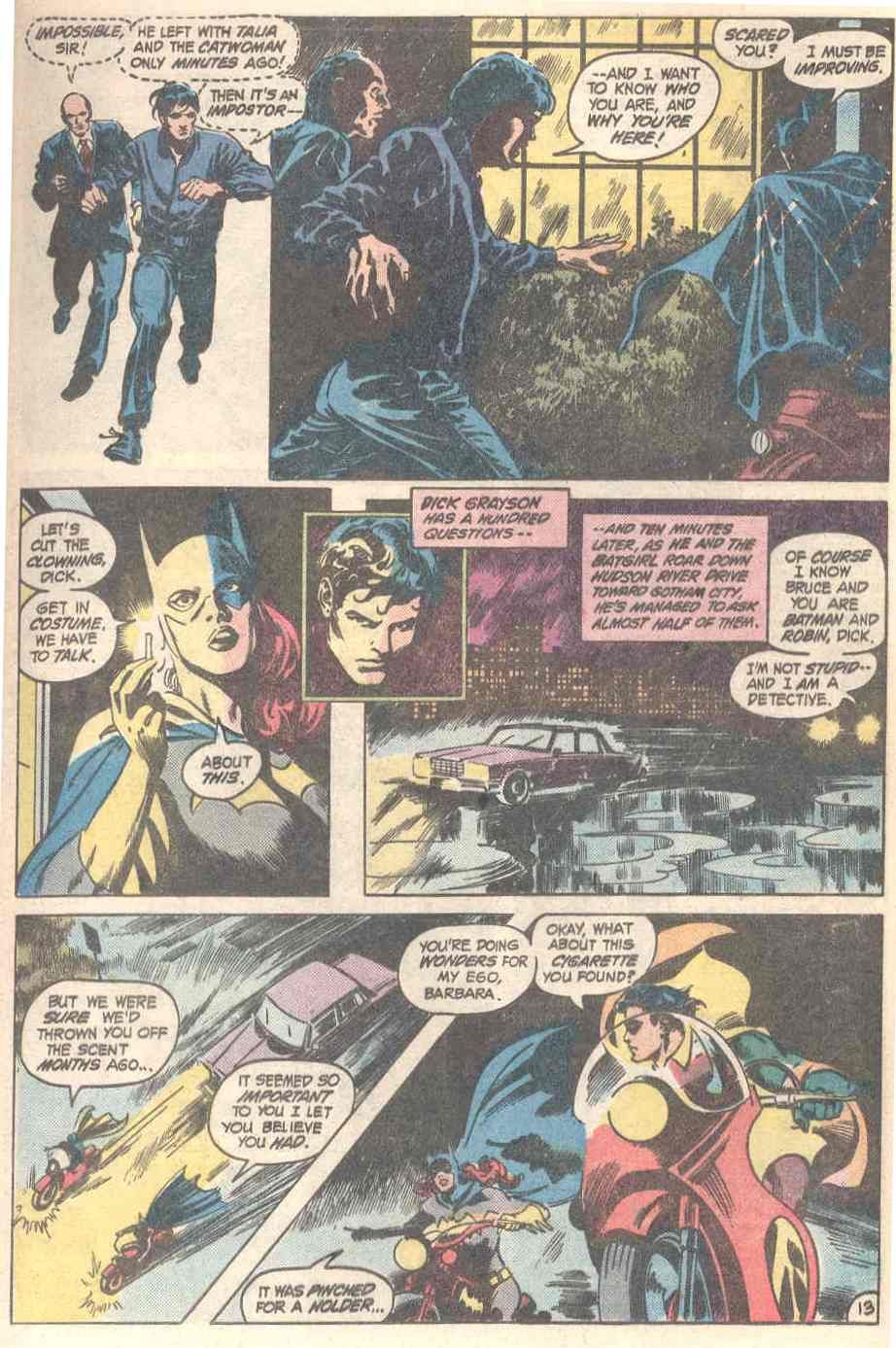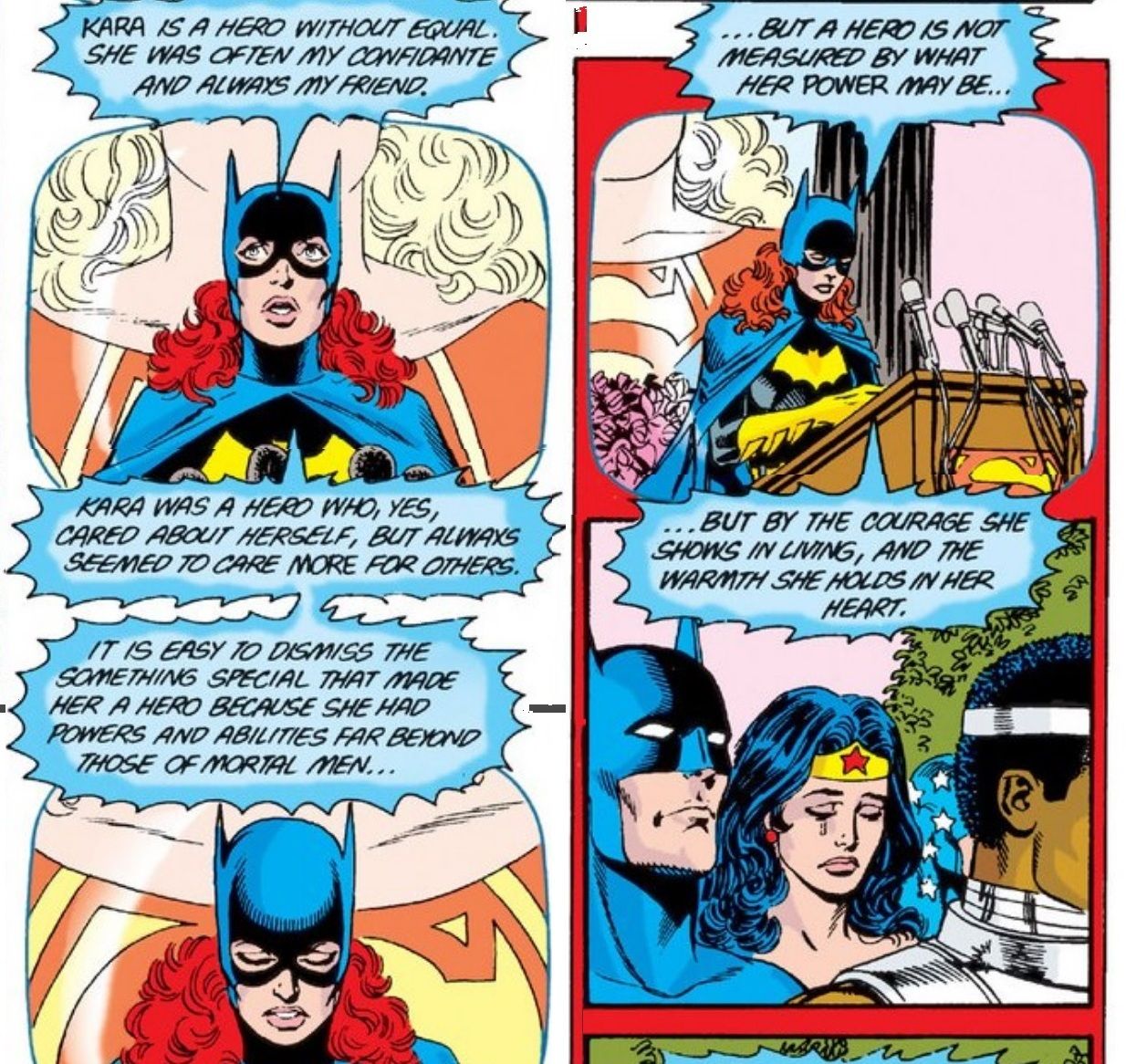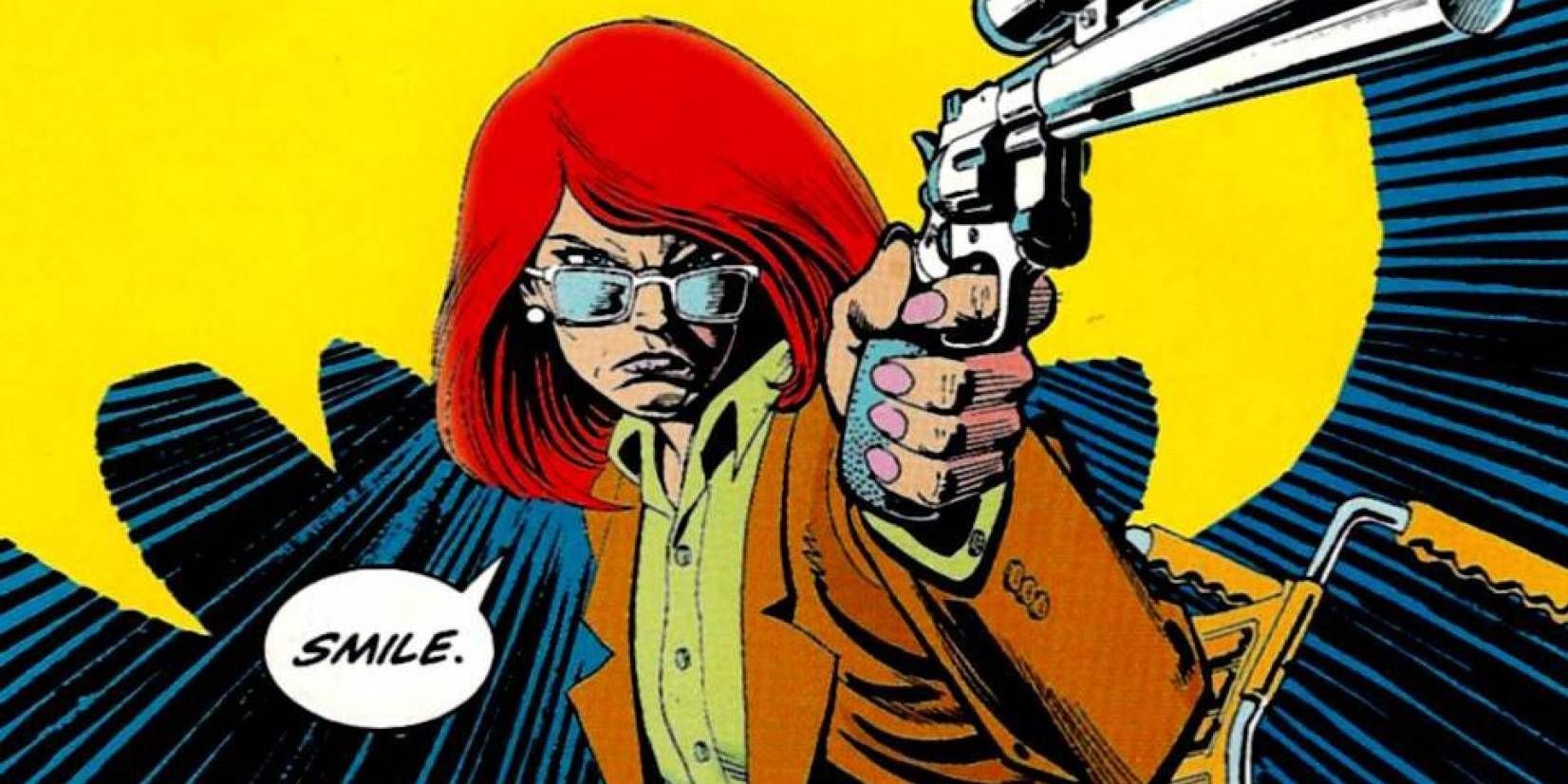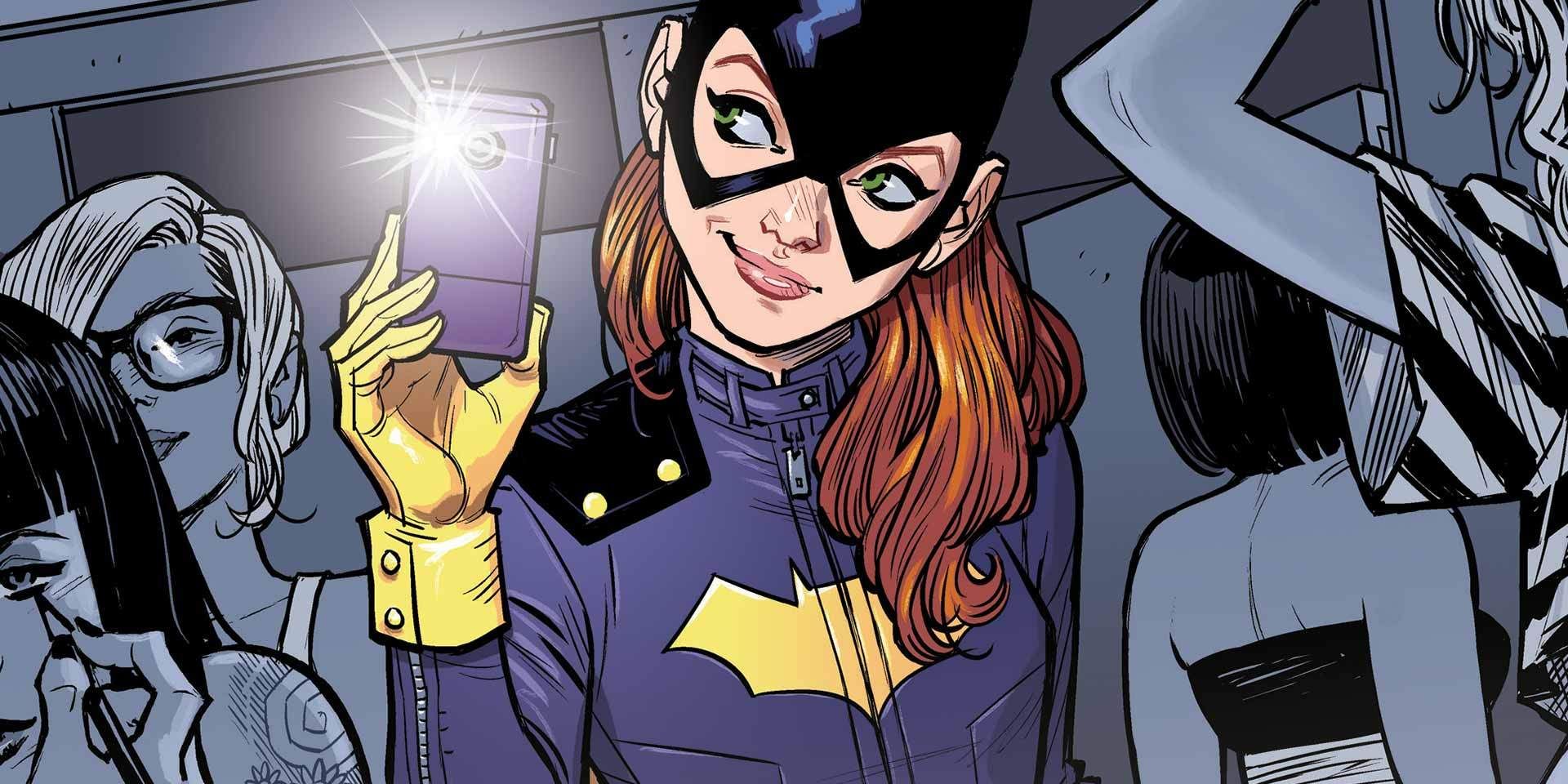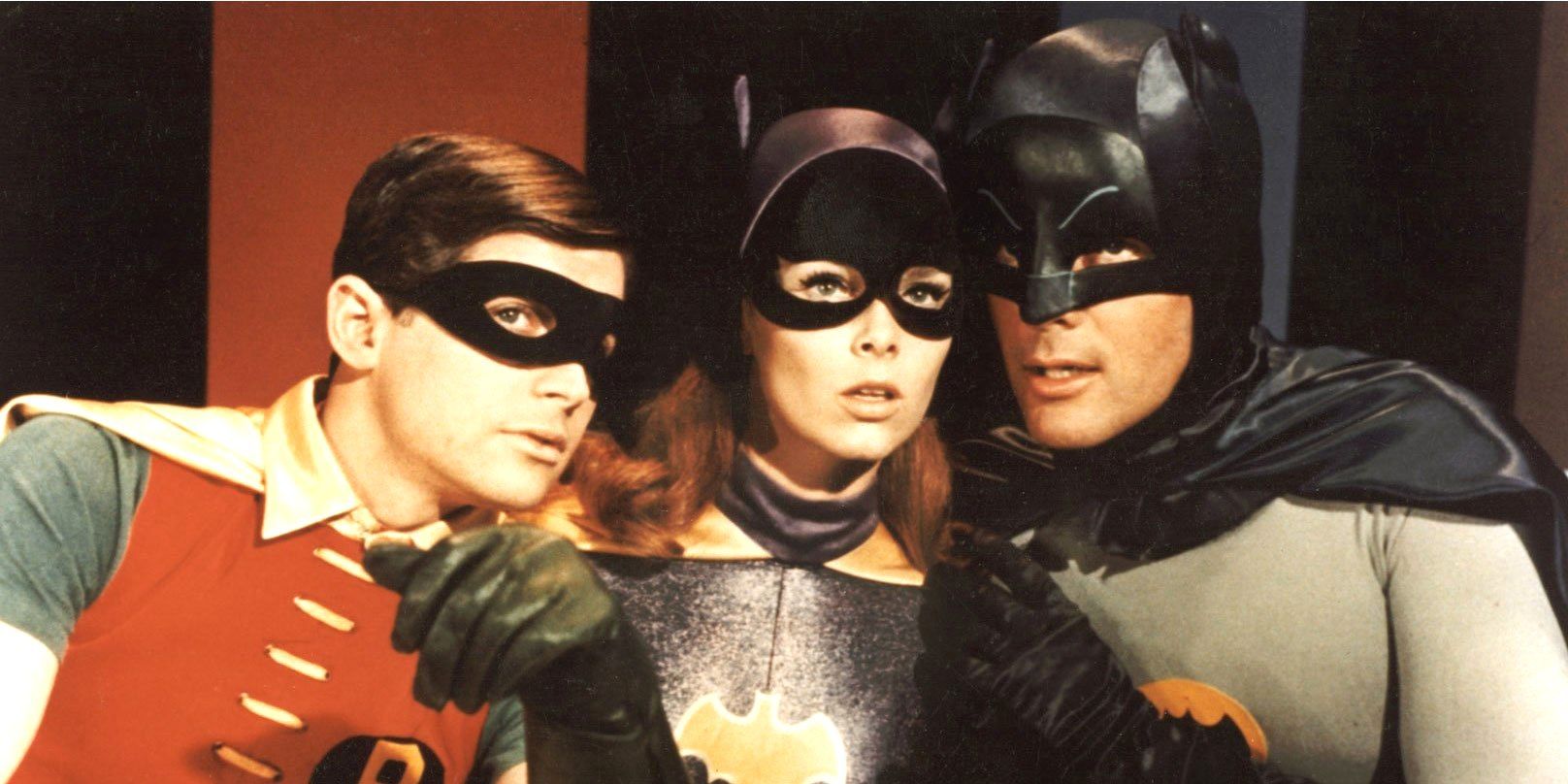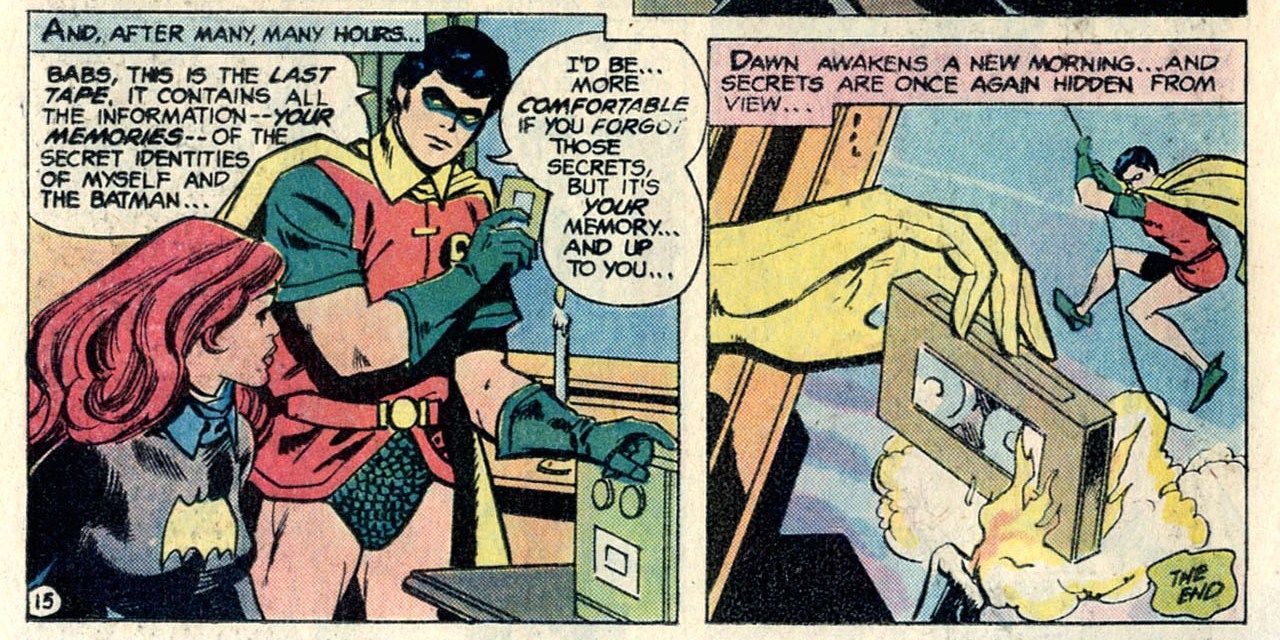January 1967's "Detective Comics" issue #359 introduced readers to Barbara Gordon, a character who would have a profound impact on its superhero comics -- although certainly not in the way her creators originally intended. Described therein as a Gotham City librarian with both a Ph.D. and a brown belt in judo (not to mention a certain police-commissioner dad), Barbara's homemade bat-costume came in handy when she tried to rescue Bruce Wayne from Killer Moth and his Mothmen. The encounter made her miss the Policeman's Masquerade Ball, but it set "Batgirl" on the path of a decades-long crimefighting career.
RELATED: Robin & Batgirl Leap Into Action On LEGO Batman IMAX Poster
Indeed, whether clobbering crooks in a Batsuit or outwitting evildoers as Oracle, Barbara Gordon has taken the worst superhero comics have to offer and come out better than ever. Today we're looking back on fifty years' worth of resilience and adaptability.
THE NEW LOOK
When editor Julius Schwartz took over "Batman" and "Detective Comics" in 1964, his "New Look" included some significant changes. The familiar stylized work of artist Dick Sprang gave way to the more naturalistic approach of Carmine Infantino, who had designed the Silver Age Flash for Schwartz back in 1956. Likewise, writers John Broome and Gardner Fox (who had also worked for Schwartz on the revamped "Flash" and "Green Lantern") refocused the Dynamic Duo on street-level crime and villainy, instead of the wild sci-fi and fantasy which had come to typify their adventures. Those otherworldly stories were meant to attract readers from the more popular Superman books, and so were a handful of other characters like Ace the Bat-Hound (shades of Krypto) and Bat-Mite (a counterpart, and sometimes foe, of Mr. Mxyzptlk).
When the stories shifted, those characters went away, along with female counterparts Batwoman and Bat-Girl. (Note the hyphen.) Batwoman -- secretly heiress and ex-acrobat Kathy Kane -- had been a regular member of the supporting cast since her introduction in July 1956's "Detective" issue #233, appearing 38 times in just under eight years. Her final appearance was in March 1964's "Detective" issue #325, two issues before the New Look began.
Bat-Girl (Betty Kane, Kathy's niece) wasn't as prolific. From her debut in April 1961's "Batman" issue #139 until her last pre-New Look story in November 1963's "Detective" issue #322, she had only six appearances in two-and-a-half years. (However, both Kathy and Betty resurfaced in the mid-'70s -- Kathy in "Batman Family" and "Detective" and Betty in "Teen Titans" -- and more recently, sort of, in the "Batwoman" feature and Grant Morrison's Bat-work.)
Accordingly, while there were comics precedents for Bat-women, Batgirl's story probably starts when "Batman" TV producer William Dozier thought a female crimefighter would help the show's declining second-season ratings. Nevertheless, the no-hyphen Batgirl would show up first in the comics. Infantino designed her costume and Fox and Schwartz co-plotted "The Million Dollar Debut of Batgirl!" (written by Fox and drawn by Infantino and Sid Greene) for the aforementioned "'Tec" issue #359. Played by Yvonne Craig, Batgirl made her first television appearance almost a year later, when ABC's "Batman" started its third and final season on September 14, 1967.
By that time the comics' Batgirl had proven to be pretty popular, with subsequent appearances in both Bat-books and a Supergirl team-up in September 1967's "World's Finest Comics" issue #169. She guest-starred in "Justice League of America" issue #60 (February 1968) and notched a couple more "World's Finest" stories and another Supergirl team-up in "Adventure Comics" #381 (June 1969) before landing a semi-regular backup feature in "Detective" (starting with October 1969's issue #392). Although the "Batman" TV series aired its final episode on March 14, 1968, Batgirl was still going strong in print.
THE BRONZE AGE
Nevertheless, just as Batwoman and Bat-Girl were too cartoonish for the New Look, Batgirl might have suffered similarly from her association with the "Batman" TV show. As Denny O'Neil and Neal Adams headed up the watershed "Darknight Detective" makeover of the early '70s -- and Batman started working solo -- both Batgirl and Robin were relegated to backup features (although Robin still had "Teen Titans").
When the "Detective" backups ended in July 1972's issue #424, Batgirl dropped out of sight for a few years, except (oddly enough) for appearances in "Superman" issues #268 and #279 (October 1973 and September 1974) and "Superman Family" issue #171 (June-July 1975). Part of the reason for this was Barbara's election to Congress in "Detective" #424, in the prematurely-titled "Batgirl's Last Case" (written by Frank Robbins and drawn by Don Heck).
Fortunately, the "Batman Family" anthology kicked off in September-October 1975, with Batgirl and Robin the main attractions. Batgirl appeared in almost all of its 20 bimonthly issues, and when "BatFam" bit the dust in October-November 1978, Batgirl moved back to a regular "Detective" spot. Off and on, Batgirl was in "Detective" from December 1978-January 1979's issue #481 to October 1982's issue #519 -- along the way, losing her Congressional seat in "Detective" issue #488 (February-March 1980). Readers also got to see her long-lost brother Tony (introduced 'way back in August-September 1951's "World's Finest Comics" issue #53), but only briefly, prior to his untimely death (February-March 1979's "Detective" #482). After this latest round of "'Tec" backups ended, Batgirl was an occasional part of the Batman supporting cast (including the storyline which introduced Jason "Robin" Todd) through January 1985's "Detective" issue #546.
For a character not normally associated with cosmic cataclysms, "Crisis On Infinite Earths" had a profound effect on Batgirl. Under "Crisis" creators Marv Wolfman and George Pérez, she compared herself unfavorably to BFF Supergirl, and ended up delivering the Maid of Might's eulogy in "Crisis" issue #7. In real-world terms, "Crisis'" housecleaning apparently forced DC to choose which counterparts would survive: Supergirl or Power Girl, and Batgirl or the Huntress. Because Huntress was the daughter of Earth-Two's deceased Batman and Catwoman, that choice seemed pretty clear; and Batgirl and Power Girl were spared.
Still, it wasn't exactly a boon to Batgirl. When Frank Miller and David Mazzucchelli revised Batman's origin in "Batman: Year One" ("Batman" issues #404-07, February-May 1987), a subplot established that James Gordon and his wife Barbara Kean didn't have a daughter old enough to be the future Batgirl (or, for that matter, a son old enough to be brother Tony). This forced DC to explain that Batgirl was really Jim's niece, raised by him after her parents died -- i.e., after "Year One" -- and the two considered each other father and daughter from that point forward.
Moreover, Supergirl's funeral might well have been Batgirl's last major in-universe public appearance, because DC officially retired the character with 1988's "Batgirl Special" (written by Barbara Randall and drawn by Barry Kitson and Bruce Patterson). Very shortly after the "Batgirl Special" hit the shelves, Alan Moore and Brian Bolland's "The Killing Joke" followed.
ORACLE
Whatever one thinks about Barbara's role in "The Killing Joke," becoming the world's greatest computer expert re-framed her character irrevocably. Seen originally as the anonymous "Oracle" (starting in January 1989's "Suicide Squad" issue #23) and then behind the pseudonym "Amy Beddoes," Barbara soon earned the reputation of being one of the smartest, best-connected crimefighters in DC's shared universe. "Squad" co-writer Kim Yale simply refused to let "Killing Joke" be the last word on Barbara Gordon, so she and her husband (co-writer John Ostrander) transformed Babs into the kind of super-sleuth Batgirl never was. Paralyzed from the waist down but blessed with an eidetic memory, a librarian's training, and virtually unlimited resources, Oracle used her incredible computer skills in "Suicide Squad," the then-current "Manhunter" series (another Ostrander/Yale-written title) and "Hawk and Dove" (written by Barbara Kesel, neé Randall) before forming her own loose-knit group of operatives.
The first "Black Canary/Oracle: Birds Of Prey" special appeared in 1996, courtesy of writer Chuck Dixon -- who, along with "Sword of Azrael" writer Denny O'Neil, had been using Oracle in the Bat-books since "Suicide Squad" folded in 1992 -- and artist Gary Frank. A four-issue miniseries and a handful of one-shots followed (all written by Dixon and drawn by various artists), until "Birds of Prey" became an ongoing series in late 1998 (issue #1 was cover-dated January 1999). By then Oracle had graduated to Justice League membership (as of March 1998's "JLA" issue #16), which, if nothing else, cemented her spot at the heart of DC's superhero community.
Under Dixon and his artistic collaborators (starting with Greg Land), "BOP" was a reliably-entertaining mashup of espionage and superheroics, with a wide-ranging array of guest stars including Nightwing, Blue Beetle, a Guy Gardner clone and Power Girl. When writer Gail Simone and artist Ed Benes took over (starting in August 2003's issue #56), the series found a whole other gear. Simone and Benes made the volatile Huntress -- in the post-"Crisis" world, schoolteacher Helena Bertinelli -- a regular castmember, and from the very first storyline demonstrated just how tough these characters were. Dixon wrote Oracle and Black Canary as seasoned professionals, and Simone built on that, diving deep into the pair's relationship and expanding the cast to highlight other character interactions.
For the character of Barbara Gordon specifically, though, "Birds of Prey" meant about 15 years' worth of being written either by Chuck Dixon or Gail Simone, with occasional stints from the likes of Terry Moore, Gilbert Hernandez -- yes, that Gilbert Hernandez -- and Tony Bedard. Those are pretty good caretakers. Oracle was always more than an exposition generator, but "BOP" showed how smart, devoted, stubborn and fearless she had become. From the identity's "Suicide Squad" beginnings it was a rebuke not just to the Joker's assault, but to those inside DC itself who considered her disposable.
BATGIRL RETURNS
While Oracle was changing the way DC's super-folk processed information, DC was trying to figure out what to do about Batgirl. In 1994's "Zero Hour" event, Oracle came face-to-face with a time-anomaly Batgirl who might have foreshadowed Barbara's relatively-speedy return to the role. Later, sometime around 1999 (according to an interview lost in the mists of Internet history), artist Alex Ross and writer Paul Dini wanted to heal Barbara Gordon with a Lazarus Pit. Ross's redesigned Batgirl costume would have been very similar to the classic Infantino look, except with red highlights instead of yellow to symbolize her being "compromised" by the Pit. Bat-editor Denny O'Neil passed on Ross and Dini's pitch, citing Oracle's popularity.
Instead, 1999's year-long Bat-event "No Man's Land" featured two new Batgirls, the moonlighting Huntress and the assassin's daughter Cassandra Cain. Cassandra emerged from the event with her own series (73 issues, 2000-06) but her story had a somewhat downbeat (although non-fatal) end. In the wake of Bruce Wayne's apparent death, Cass passed the Batgirl mantle along to ex-Spoiler and ex-Robin Stephanie Brown, whose solo series lasted 24 issues (2009-11). However, once again DC had considered having Barbara (instead of Stephanie) return as Batgirl.
Of course, Barbara was healed and back in her Batgirl costume when the New 52 relaunch kicked off in September 2011. (At that time her 23-year Oracle career was longer than her original Batgirl stint.) Initially, Gail Simone wrote that volume of "Batgirl" and -- as you might expect from someone who wrote Oracle for several years -- was careful not to downplay Barbara's past trauma or the lingering effects of her recovery. Simone left after three years on "Batgirl," and the creative team of Brenden Fletcher, Cameron Stewart and Babs Tarr remade Barbara into the so-called "Batgirl of Burnside," brightening the book's tone and emphasizing the character's youth and optimism.
In a move which fans welcomed, Fletcher, Stewart and Tarr also hinted strongly that for this version of Barbara, "The Killing Joke" was merely a bad memory, implanted malevolently by a supervillain seeking to undermine Batgirl. However, the subsequent "Batgirl and the Birds of Prey" series (written by Julie and Shawna Benson) has kept "Killing Joke" in continuity. Despite that, and the departure of Fletcher, Stewart and Tarr, the current "Batgirl" creative team of writer Hope Larson and artist Rafael Albuquerque have maintained the character's can-do spirit.
MULTIMEDIA MAVEN
Since Barbara Gordon was born at least partially out of a TV producer's necessity, she may be the highest-profile DC character with such a mixed-media pedigree. (She's at least neck-and-neck with Jimmy Olsen, ported to the comics from the "Superman" radio show.) While the "Batman" TV series only ran for a little over two years, its success in syndication gave Yvonne Craig's Batgirl at least a couple of decades' worth of new viewers. Barbara Gordon (played by Dina Meyer) returned to live-action as Oracle (and, in flashbacks, Batgirl) for 2002's short-lived "Birds of Prey" series on The WB. A few years prior in 1997, Alicia Silverstone had played Alfred Pennyworth's niece Barbara Wilson, who ended up becoming Batgirl in the Joel Schumacher-directed "Batman and Robin" movie; but the jury's probably out as to whether it was a proper Babs Gordon adaptation. By the way, we're now curious to see whether Babs will make it into Margot Robbie's "Gotham City Sirens" movie.
Starting in 1968 with the "Adventures of Batman" cartoon, Barbara and Batgirl have also appeared on just about every long-running Batman animated series (not including the team-oriented "Super Friends" or "Justice League" shows). She was a prominent part of 1977's "New Adventures of Batman" and made several appearances on "Batman: The Animated Series" (voiced by Melissa Gilbert) and its successor shows (where she was voiced by Mary Kay Bregman and Tara Strong). In the second-generation future of "Batman Beyond," Barbara (voiced by Stockard Channing and then Angie Harmon) had become Police Commissioner; and Batgirl and Oracle both appeared on the 2004-08 "The Batman" cartoon, voiced at various points by Danielle Judovits, Kellie Martin and Ellen Yin. Mae Whitman voiced Batgirl on the 2008-11 "Batman: The Brave and the Bold" series and in the current "DC Super Hero Girls"; and Alyson Stoner played her on "Young Justice."
Batgirl also appeared in a number of standalone and short-form animated DC projects, from the Animated Series spinoff "Gotham Girls" and Lauren Faust's "Super Best Friends Forever" to adaptations of comics storylines like "Under the Red Hood" and "Bad Blood." Rosario Dawson will voice the character in the upcoming "LEGO Batman Movie." (SPOILERS -- she's not in the "Batman '66" animated homage "Return of the Caped Crusaders," although she could have come in handy especially in its third act.)
Most recently, of course, Tara Strong returned to voice Barbara/Batgirl in July 2016's animated "Killing Joke" (which also featured Animated Series vets Kevin Conroy and Mark Hamill). This adaptation tried to mitigate the graphic novel's treatment of Barbara by showing her in action as Batgirl, but its efforts were hamstrung by giving her and Batman an ill-advised sexual relationship.
THE SELF-MADE (AND REMADE) HEROINE
This latest "Killing Joke" controversy followed 2015's solicitation of a now-infamous variant cover for Fletcher, Stewart and Tarr's "Batgirl" issue #41. Drawn by Rafael Albuquerque, who (as mentioned above) went on to draw the Rebirthed "Batgirl" series, the cover depicted a tearful Batgirl in her "Burnside"-style costume and Joker-esque lipstick, held hostage at gunpoint by the villain. When fans who objected to the variant cover were harassed and threatened over social media, upon Albuquerque's request DC canceled the variant.
Regardless, the "Killing Joke"-related controversies are just some of the ways DC has both supported and undermined Barbara over the years. The 2011 "Batgirl" relaunch managed to do both, by giving Simone one of her "dream jobs" and "the reason [she] fell in love" with both comics and superheroes. Nevertheless, DC fired Simone abruptly (and somewhat mysteriously) towards the end of 2012, only to reinstate her less than two weeks later. Although Simone's "Batgirl" work tended to be very dark, especially where long-lost sociopathic brother James Jr. was concerned, it struck more blows for diversity, including a crossover with Simone's super-activist team book "The Movement." However, ending Barbara's Oracle career also made the DC Universe a little less diverse, and fans took note of that as well. Still, when Simone left "Batgirl" for good, fans worried that her successors wouldn't keep transgender supporting character Alysia Yeoh, whom GLAAD described as "the first major transgender character written in a contemporary context in a mainstream comic book." Alysia stuck around; but in 2013 Fletcher, Stewart and Tarr faced their own trans-related controversy, thanks to Batgirl's horrified reaction to the villain Dagger Type.
This sort of back-and-forth was nothing new. In the 1970s, after the costumed Yvonne Craig starred in a public service announcement about equal pay and the comics' Barbara Gordon fought for prison reform in Congress, Batgirl forgot Batman and Robin's secret identities. It happened via a total mind-wipe in 1979's "Detective" #489 (written by Jack C. Harris, pencilled by Don Heck and inked by Vince Colletta); and when Robin helped restore Babs' memories, she chose not to restore everything, even though they still knew her secrets. A few years later, Batgirl revealed in "Detective" #526 that she'd re-learned their identities -- "I'm not stupid, and I am a detective," she reminded Robin -- and wisely, the comics have spoken no more of it.
Similarly, after Barbara was spared a 1985 "Crisis" death only to be written out of 1987's "Batman: Year One" and retired in 1988's "The Killing Joke," in 1989 DC revived the character "Crisis" sacrificed for her sake. Helena Bertinelli's "Huntress" ongoing series (19 issues in 1989-90) was short-lived, but she went on to work frequently with the Bat-clan, and eventually joined the Justice League (twice) in addition to the Birds of Prey.
Despite all of this, and regardless of method or heroic identity, Barbara Gordon has never really gone away. If she was considered an artifact of the '60s Batmania fad, she proved her staying power in the '70s. In the wake of "The Killing Joke," she was remade as an even stronger, and arguably more important, character. When other women took up the Batgirl mantle, she evaluated and mentored them. When she returned as Batgirl herself, she learned from her traumatic experiences and helped others do the same.
As it happens, long before Tim Drake and his two living parents entered the picture, Barbara Gordon was the most prominent Bat-character without a tragic background. Although the Silver Age was silent on what happened to Jim Gordon's wife (apparently she died sometime after Tony and Barbara were born), Barbara fights crime simply because it is a chance to do good. From the moment in "Detective" #359 when she sees Killer Moth's goons abducting Bruce Wayne, she springs into action without a second thought; and as the narration describes, "Babs Gordon is having the time of her life -- fully alive to this new excitement and danger -- and loving it!"
That sums up Barbara's appeal pretty well. Like Bruce Wayne, she's a self-made crimefighter; but unlike him and many of his associates, she didn't always have exotic training or limitless resources. She became Batgirl virtually without anyone's help, and she reinvented herself as Oracle when her old life had been ripped away. Even the "Batgirl of Burnside" modus operandi has a very DIY (or dare we say "artisanal?") feel. Maybe Tim Drake should have sought her out -- but wait, he couldn't have, because clearly Oracle hid her real identity better than Batman and Nightwing did!
As Batgirl said at Supergirl's funeral, "[a] hero is not measured by what her power may be, but by the courage she shows in living, and the warmth she holds in her heart." Over the course of fifty years, Barbara Gordon has inspired fans of all kinds with her own courage and warmth. We salute her on her anniversary, and look forward to many more.
How are you celebrating Barbara Gordon's 50th? Let us know in the comments!

